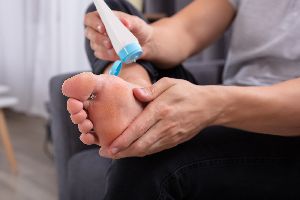4 Tips for Diabetic Foot Care

When you are diagnosed with diabetes, the condition can damage the nerves in your extremities, preventing you from feeling injuries. This is especially dangerous for your feet, as calluses, blisters, and other issues are more common and more likely to become infected. Practicing proper diabetic foot care and visiting a podiatrist whenever you have a problem will help prevent these problems from worsening. Below are several strategies to help.
What Are the Best Ways to Care for Feet When You Have Diabetes?
1. Check Feet Daily
Similar to other health problems, finding issues early allows you to treat them before they worsen. For your feet, examine the top and bottom of each foot at least once a day. Use a mirror or enlist a family member if you have trouble seeing the entire area. Check for cuts, sores, blisters, swelling, and nail abnormalities. If you see anything out of the ordinary, clean the wound thoroughly and bandage it to prevent an infection.
2. Wash, Dry & Moisturize

Keeping your feet clean removes any dirt and debris that can get inside cuts and scrapes, helping prevent infections. Wash your feet gently using a soft sponge with mild soap in lukewarm water. Avoid hot water, as it can scald and dry out skin, resulting in cracking and irritation.
Afterward, dry your feet thoroughly, especially between the toes. Apply lotion or petroleum jelly to the entire foot, except the areas between the toes. These crevices trap moisture, which can invite fungus that leads to pain, infections, and nail damage.
3. Wear the Proper Shoes & Socks
Properly fitting shoes are essential because if they are too tight you are more likely to experience an injury. This means that you should opt for shoes that have extra room in the toe box and sufficient coverage on the top and bottom. Also, avoid options that have many seams, as these can rub and chafe your feet. For further protection, use specially designed diabetic socks, as these have more cushioning and are made of a moisture-wicking fabric.
4. Avoid Bare Feet
Even if you are only walking around the house, always protect your feet. Whether you prefer slippers or sandals, wearing shoes inside ensures you don't accidentally step on something that cuts your foot. For example, if you have kids, stray toys, sharp objects, and other debris can be scattered around the house. Stepping on these objects can puncture your skin, increasing the risk of an infection.
If you need help practicing proper diabetic foot care, contact St. Peters Foot & Ankle: Samual T. Wood-DPM, LLC. With locations in St. Peters and Florissant, MO, this podiatrist provides high-quality care for a range of foot problems, including sprained ankles, fractures, and bunion. Call (636) 720-0190 to schedule an appointment, and visit the website to learn more about their services.
About the Business
Have a question? Ask the experts!
Send your question

